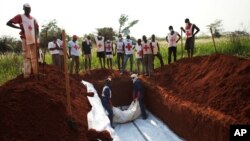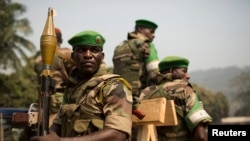BANGUI —
People in the Central African Republic say they had never seen anything like the violence between Muslims and Christians that has shaken the country in the past year. Analysts are looking into how this religious divide emerged and what can be done to overcome it.
"Kilometre Cinq" is one of the neighborhoods in Bangui where Muslims have congregated since violence between Muslims, Christians and animists exploded in early December and at least 750 people in the capital were killed. Last week the violence flared again and a mob demolished the mosque in this district.
Local resident Eloge Alokaya says he saw them doing it.
He says they were from this neighborhood, they were angry and they started by looting the imam’s house and finished by destroying the mosque.
Asked if Muslims and Christians could live together again in this neighborhood, Alokaya said they could if the government wanted it. Another neighbor wanted to make the Muslims’ return conditional on them giving up their weapons.
A Catholic priest, Abbe Albert Tungumale-Baba, agrees that disarmament will be necessary.
He tells VOA the army needs to go into the neighborhoods where arms are hidden and find them. He says it could do this with the population’s help as people know where the weapons are.
Mixed neighborhoods
Until recently, Christians and Muslims lived in mixed neighborhoods in Bangui, and they still do in the daytime, which could be an advantage for security forces trying to disarm sectarian gangs.
Since December 5, however, Christians and Muslims have preferred to live separately at night. Hundreds of thousands of Christians sleep at a camp at the airport or in the yards around churches.
Christians fear the largely Muslim Seleka militia, which they say has been killing and looting since it took control of the capital in March, while Muslims fear the anti-Balaka militia which killed many people in December.
So how did this country, which was never known for sectarian violence, suddenly divide along religious lines?
Sudden divide
University lecturer Mondesir Oualou Panouala has this to say about the history of Islam in the Central African Republic.
He says that Islam first arrived in the country in the 16th century, whereas Christianity did not arrive until the 19th century, but the Muslims remained a minority, mainly in the north but also in part of the west. People who suggest the country should be divided into a Muslim north and a Christian south are forgetting about the Muslims in the west, he says.
And he adds CAR’s Muslims have never been known for radical Islamism.
"What’s different about Muslims and Christians in the CAR is that they resemble each other in every way," he said. "They eat all the same things, drink all the same things, study in the same conditions, here and abroad and even physically it’s difficult to tell them apart."
It seems clear that although there have been interfaith conversions, people’s religion here largely depends on which ethnic community they belong to.
Images from the Central African Republic
Getting to the root of the problem
So how did the communities turn on each other?
Brice Kevin Kakpayen, a member of the transitional parliament, spoke to VOA outside a church in Bangui.
Kapeyen says there had long been conflicts between ethnic communities in CAR that till the land and others that herd cattle, and in the north the cattle herders have tended to be Muslim. These conflicts have often been settled hastily, he says, without tackling the roots of the problem.
But, he says, the communities could generally settle those problems in a traditional way. He dates the increasing hostility between Christians and Muslims to an army mutiny in 1996 which gave Muslims more political power but also made them unpopular, particularly as many of the mutineers were of Chadian origin.
The Seleka rebellion
Many CAR citizens see a similarity in the Seleka rebellion which took power in Bangui in March last year. The Seleka are mainly Muslims, and many are from Chad or Sudan.
According to Human Rights Watch, after taking power the Seleka continued to pillage the country and commit atrocities. But Human Rights Watch also stresses that the Seleka were taking revenge for atrocities committed in their areas.
The CAR’s senior Muslim cleric, Imam Omar Kobine Layama, says that for reconciliation to happen people must look back at a long history of injustice and violence.
"Since independence, Central Africans have suffered injustice and the fight against injustice should be a mechanism for putting the country back on track," he said.
"Kilometre Cinq" is one of the neighborhoods in Bangui where Muslims have congregated since violence between Muslims, Christians and animists exploded in early December and at least 750 people in the capital were killed. Last week the violence flared again and a mob demolished the mosque in this district.
Local resident Eloge Alokaya says he saw them doing it.
He says they were from this neighborhood, they were angry and they started by looting the imam’s house and finished by destroying the mosque.
Asked if Muslims and Christians could live together again in this neighborhood, Alokaya said they could if the government wanted it. Another neighbor wanted to make the Muslims’ return conditional on them giving up their weapons.
A Catholic priest, Abbe Albert Tungumale-Baba, agrees that disarmament will be necessary.
He tells VOA the army needs to go into the neighborhoods where arms are hidden and find them. He says it could do this with the population’s help as people know where the weapons are.
Mixed neighborhoods
Until recently, Christians and Muslims lived in mixed neighborhoods in Bangui, and they still do in the daytime, which could be an advantage for security forces trying to disarm sectarian gangs.
Since December 5, however, Christians and Muslims have preferred to live separately at night. Hundreds of thousands of Christians sleep at a camp at the airport or in the yards around churches.
Christians fear the largely Muslim Seleka militia, which they say has been killing and looting since it took control of the capital in March, while Muslims fear the anti-Balaka militia which killed many people in December.
So how did this country, which was never known for sectarian violence, suddenly divide along religious lines?
Sudden divide
University lecturer Mondesir Oualou Panouala has this to say about the history of Islam in the Central African Republic.
He says that Islam first arrived in the country in the 16th century, whereas Christianity did not arrive until the 19th century, but the Muslims remained a minority, mainly in the north but also in part of the west. People who suggest the country should be divided into a Muslim north and a Christian south are forgetting about the Muslims in the west, he says.
And he adds CAR’s Muslims have never been known for radical Islamism.
"What’s different about Muslims and Christians in the CAR is that they resemble each other in every way," he said. "They eat all the same things, drink all the same things, study in the same conditions, here and abroad and even physically it’s difficult to tell them apart."
It seems clear that although there have been interfaith conversions, people’s religion here largely depends on which ethnic community they belong to.
Images from the Central African Republic
Getting to the root of the problem
So how did the communities turn on each other?
Brice Kevin Kakpayen, a member of the transitional parliament, spoke to VOA outside a church in Bangui.
Kapeyen says there had long been conflicts between ethnic communities in CAR that till the land and others that herd cattle, and in the north the cattle herders have tended to be Muslim. These conflicts have often been settled hastily, he says, without tackling the roots of the problem.
But, he says, the communities could generally settle those problems in a traditional way. He dates the increasing hostility between Christians and Muslims to an army mutiny in 1996 which gave Muslims more political power but also made them unpopular, particularly as many of the mutineers were of Chadian origin.
The Seleka rebellion
Many CAR citizens see a similarity in the Seleka rebellion which took power in Bangui in March last year. The Seleka are mainly Muslims, and many are from Chad or Sudan.
According to Human Rights Watch, after taking power the Seleka continued to pillage the country and commit atrocities. But Human Rights Watch also stresses that the Seleka were taking revenge for atrocities committed in their areas.
The CAR’s senior Muslim cleric, Imam Omar Kobine Layama, says that for reconciliation to happen people must look back at a long history of injustice and violence.
"Since independence, Central Africans have suffered injustice and the fight against injustice should be a mechanism for putting the country back on track," he said.

